Synthesis of Nano-Structured Ge as Transmissive or Reflective Saturable Absorber for Mode-Locked Fiber Laser
Abstract
:1. Introduction
2. Materials and Methods
2.1. Fabrications of α-Ge and Ge-NP/Au Films
2.2. Nonlinear Transmittance Analysis of the α-Ge and Ge-NP/Au Films
2.3. Setup of Transmissive- and Reflective-Type Mode-Locked EDFL Systems
3. Results and Discussion
3.1. Material and Nonlinear Optical Properties of the Ge-NP/Au and α-Ge Films
3.2. Nonlinear Transmissive Analysis of Transmissive-Type α-Ge and Reflective-Type Ge-NP/Au Films
3.3. Mode-Locking Performances of the Transmissive-Type α-Ge and Reflective-Type Ge-NP Saturable Absorber-Enabled Ge-Based EDFL System
4. Conclusions
Author Contributions
Funding
Data Availability Statement
Conflicts of Interest
References
- Set, S.; Yaguchi, H.; Tanaka, Y.; Jablonski, M. Laser Mode Locking Using a Saturable Absorber Incorporating Carbon Nanotubes. J. Light. Technol. 2004, 22, 51–56. [Google Scholar] [CrossRef]
- Mas-Ballesté, R.; Gómez-Navarro, C.; Gómez-Herrero, J.; Zamora, F. 2D materials: To graphene and beyond. Nanoscale 2011, 3, 20–30. [Google Scholar] [CrossRef] [PubMed]
- Novoselov, K.S.; Geim, A.K.; Morozov, S.V.; Jiang, D.; Zhang, Y.; Dubonos, S.V.; Grigorieva, I.V.; Firsov, A.A. Electric field effect in atomically thin carbon films. Science 2004, 306, 666–669. [Google Scholar] [CrossRef] [PubMed]
- Novoselov, K.S.; Jiang, D.; Schedin, F.; Booth, T.J.; Khotkevich, V.V.; Morozov, S.V.; Geim, A.K. Two-dimensional atomic crystals. Proc. Natl. Acad. Sci. USA 2005, 102, 10451–10453. [Google Scholar] [CrossRef]
- Novoselov, K.S.; Geim, A.K.; Morozov, S.V.; Jiang, D.; Katsnelson, M.I.; Grigorieva, I.V.; Dubonos, S.V.; Firsov, A.A. Two-dimensional gas of massless Dirac fermions in graphene. Nature 2005, 438, 197–200. [Google Scholar] [CrossRef]
- Katsnelson, M.I. Graphene: Carbon in two dimensions. Mater. Today 2007, 10, 20–27. [Google Scholar] [CrossRef]
- Bianco, E.; Butler, S.; Jiang, S.; Restrepo, O.D.; Windl, W.; Goldberger, J.E. Stability and exfoliation of germanane: A germanium graphane analogue. ACS Nano 2013, 7, 4414–4421. [Google Scholar] [CrossRef]
- Liang, Y.; Li, Y.; Wang, H.; Zhou, J.; Wang, J.; Regier, T.; Dai, H. Co3O4 nanocrystals on graphene as a synergistic catalyst for oxygen reduction reaction. Nat. Mater. 2011, 10, 780–786. [Google Scholar] [CrossRef]
- Fowler, J.D.; Allen, M.J.; Tung, V.C.; Yang, Y.; Kaner, R.B.; Weiller, B.H. Practical Chemical Sensors from Chemically Derived Graphene. ACS Nano 2009, 3, 301–306. [Google Scholar] [CrossRef]
- Zhang, H.; Lv, X.-J.; Li, Y.-M.; Wang, Y.; Li, J.-H. P25-graphene composite as a high performance photocatalyst. ACS Nano 2010, 4, 380–386. [Google Scholar] [CrossRef]
- Lomeda, J.R.; Doyle, C.D.; Kosynkin, D.V.; Hwang, W.-F.; Tour, J.M. Diazonium Functionalization of Surfactant-Wrapped Chemically Converted Graphene Sheets. J. Am. Chem. Soc. 2008, 130, 16201–16206. [Google Scholar] [CrossRef] [PubMed]
- Elias, D.C.; Nair, R.R.; Mohiuddin, T.M.G.; Morozov, S.V.; Blake, P.; Halsall, M.P.; Ferrari, A.C.; Boukhvalov, D.W.; Katsnelson, M.I.; Geim, A.K.; et al. Control of graphene’s properties by reversible hydrogenation: Evidence for graphene. Science 2009, 323, 610–613. [Google Scholar]
- Lee, C.; Yan, H.; Brus, L.E.; Heinz, T.F.; Hone, J.; Ryu, S. Anomalous Lattice Vibrations of Single- and Few-Layer MoS2. ACS Nano 2010, 4, 2695–2700. [Google Scholar] [CrossRef] [PubMed]
- Radisavljevic, B.; Radenovic, A.; Brivio, J.; Giacometti, V.; Kis, A. Single-layer MoS2 transistors. Nat. Nanotechnol. 2011, 6, 147–150. [Google Scholar] [CrossRef] [PubMed]
- Li, L.; Zhao, M. First-principles identifications of superstructures of germanene on Ag(111) surface and h-BN substrate. Phys. Chem. Chem. Phys. 2013, 15, 16853–16863. [Google Scholar] [CrossRef] [PubMed]
- Kaloni, T.P.; Schwingenschlögl, U. Weak interaction between germanene and GaAs(0001) by H intercalation: A route to exfo-liation. J. Appl. Phys. 2013, 114, 184307. [Google Scholar] [CrossRef]
- Kaloni, T.; Gangopadhyay, S.; Singh, N.; Jones, B.; Schwingenschlögl, U. Electronic properties of Mn-decorated silicene on hexagonal boron nitride. Phys. Rev. B 2013, 88, 235418. [Google Scholar] [CrossRef]
- Liu, H.; Gao, J.; Zhao, J. Silicene on Substrates: A Way To Preserve or Tune Its Electronic Properties. J. Phys. Chem. C 2013, 117, 10353–10359. [Google Scholar] [CrossRef]
- Kaloni, T.P. Tuning the Structural, Electronic, and Magnetic Properties of Germanene by the Adsorption of 3D Transition Metal Atoms. J. Phys. Chem. C 2014, 118, 25200–25208. [Google Scholar] [CrossRef]
- Houssa, M.; Pourtois, G.; Afanas’ev, V.V.; Stesmans, A. Electronic properties of two-dimensional hexagonal germanium. Appl. Phys. Lett. 2010, 96, 082111. [Google Scholar] [CrossRef]
- Ma, Y.; Dai, Y.; Lu, Y.-B.; Huang, B. Effective bandgap engineering in wrinkled germanane via tiny electric field. J. Mater. Chem. C 2014, 2, 1125–1130. [Google Scholar] [CrossRef]
- Li, L.; Lu, S.-Z.; Pan, J.; Qin, Z.; Wang, Y.-Q.; Wang, Y.; Cao, G.-Y.; Du, S.; Gao, H.-J. Buckled Germanene Formation on Pt(111). Adv. Mater. 2014, 26, 4820–4824. [Google Scholar] [CrossRef] [PubMed]
- Dávila, M.E.; Xian, L.; Cahangirov, S.; Rubio, A.; Lay, L.L. Germanene: A novel two-dimensional germanium allotrope akin to graphene and silicone. New J. Phys. 2014, 16, 095002. [Google Scholar] [CrossRef]
- Abderrafi, K.; Calzada, R.G.; Gongalsky, M.B.; Suárez, I.; Abarques, R.; Chirvony, V.S.; Timoshenko, V.Y.; Ibáñez, R.; Martínez-Pastor, J.P. Silicon nanocrystals produced by nanosecond laser ablation in an organic liquid. J. Phys. Chem. C 2011, 115, 5147–5151. [Google Scholar] [CrossRef]
- Boucherif, A.; Beaudin, G.; Aimez, V.; Arès, R. Mesoporous germanium morphology transformation for lift-off process and substrate re-use. Appl. Phys. Lett. 2013, 102, 011915. [Google Scholar] [CrossRef]
- Chou, N.H.; Oyler, K.D.; Motl, N.E.; Schaak, R.E. Colloidal Synthesis of Germanium Nanocrystals Using Room-Temperature Benchtop Chemistry. Chem. Mater. 2009, 21, 4105–4107. [Google Scholar] [CrossRef]
- Campbell, I.; Fauchet, P. The effects of microcrystal size and shape on the one phonon Raman spectra of crystalline semiconductors. Solid State Commun. 1986, 58, 739–741. [Google Scholar] [CrossRef]
- Keller, U. Recent developments in compact ultrafast lasers. Nature 2003, 424, 831–838. [Google Scholar] [CrossRef]
- Matsas, V.; Newson, T.; Richardson, D.; Payne, D. Selfstarting passively mode-locked fibre ring soliton laser exploiting nonlinear polarisation rotation. Electron. Lett. 1992, 28, 1391–1393. [Google Scholar] [CrossRef]
- Keller, U.; Miller, D.A.B.; Boyd, G.D.; Chiu, T.H.; Ferguson, J.F.; Asom, M.T. Solid-state low-loss intracavity saturable absorber for Nd:YLF lasers: An antiresonant semiconductor Fabry–Perot saturable absorber. Opt. Lett. 2012, 17, 505–507. [Google Scholar] [CrossRef]
- Doran, N.J.; David, W. Nonlinear-optical loop mirror. Opt. Lett. 1988, 13, 56–58. [Google Scholar] [CrossRef] [PubMed]
- Lin, Y.-H.; Yang, C.-Y.; Liou, J.-H.; Yu, C.-P.; Lin, G.-R. Using graphene nano-particle embedded in photonic crystal fiber for evanescent wave mode-locking of fiber laser. Opt. Express 2013, 21, 16763–16776. [Google Scholar] [CrossRef] [PubMed]
- Grawert, F.J.; Akiyama, S.; Gopinath, J.T.; Ilday, F.O.; Liu, J.; Shen, H.; Wada, K.; Kimerling, L.C.; Ippen, E.P.; Kaertner, F.X. Silicon-germanium saturable absorber mirrors. In Proceedings of the 17th Annual Meeting of the IEEE Lasers and Electro-Optics Society, Rio Grande, PR, USA, 11 November 2004. [Google Scholar]
- Lin, G.-R.; Lin, Y.-C. Directly exfoliated and imprinted graphite nano-particle saturable absorber for passive mode-locking erbium-doped fiber laser. Laser Phys. Lett. 2011, 8, 880–886. [Google Scholar] [CrossRef]
- Lin, Y.-H.; Lin, G.-R. Free-standing nano-scale graphite saturable absorber for passively mode-locked erbium doped fiber ring laser. Laser Phys. Lett. 2012, 9, 398–404. [Google Scholar] [CrossRef]
- Lepadatu, A.-M.; Slav, A.; Palade, C.; Dascalescu, I.; Enculescu, M.; Iftimie, S.; Lazanu, S.; Teodorescu, V.S.; Ciurea, M.L.; Stoica, T. Dense Ge nanocrystals embedded in TiO2 with exponentially increased photoconduction by field effect. Sci. Rep. 2018, 8, 4898. [Google Scholar] [CrossRef]
- Yang, C.-C.; Cheng, C.-H.; Chen, T.-H.; Lin, Y.-H.; Tseng, W.-H.; Chang, P.-H.; Wu, C.-I.; Lin, G.-R. Ultrathin amorphous Ge film enabling stabilized femtosecond fiber laser pulsation. Opt. Laser Technol. 2021, 136, 106761. [Google Scholar] [CrossRef]
- Lin, C.-Y.; Cheng, C.-H.; Chi, Y.-C.; Set, S.Y.; Yamashita, S.; Lin, G.-R. Low-Temperature PECVD Growth of Germanium for Mode-Locking of Er-Doped Fiber Laser. Nanomaterials 2022, 12, 1197. [Google Scholar] [CrossRef]
- Braeuninger-Weimer, P.; Brennan, B.; Pollard, A.J.; Hofmann, S. Understanding and Controlling Cu-Catalyzed Graphene Nucleation: The Role of Impurities, Roughness, and Oxygen Scavenging. Chem. Mater. 2016, 28, 8905–8915. [Google Scholar] [CrossRef]
- Lay, G.L.; Padova, P.D.; Resta, A.; Bruhn, T.; Vogt, P. Epitaxial silicene: Can it be strongly strained? J. Phys. D Appl. Phys. 2012, 45, 392001. [Google Scholar] [CrossRef]
- Vogt, P.; De Padova, P.; Quaresima, C.; Avila, J.; Frantzeskakis, E.; Asensio, M.C.; Resta, A.; Ealet, B.; Le Lay, G. Silicene: Compelling Experimental Evidence for Graphenelike Two-Dimensional Silicon. Phys. Rev. Lett. 2012, 108, 155501. [Google Scholar] [CrossRef]
- Voon, L.C.L.Y.; Sandberg, E.; Aga, R.S.; Farajian, A.A. Hydrogen compounds of group-IV nanosheets. Appl. Phys. Lett. 2010, 97, 163114. [Google Scholar] [CrossRef]
- Hanrath, T.; Korgel, B.A. Nucleation and growth of germanium nanowires seeded by organic monolayer-coated gold nano-crystals. J. Am. Chem. Soc. 2002, 124, 1424–1429. [Google Scholar] [CrossRef] [PubMed]
- Vadavalli, S.; Valligatla, S.; Neelamraju, B.; Dar, M.H.; Chiasera, A.; Ferrari, M.; Desai, N.R. Optical properties of germanium nanoparticles synthesized by pulsed laser ablation in acetone. Front. Phys. 2014, 2, 57. [Google Scholar] [CrossRef]
- Lepadatu, A.-M.; Stoica, T.; Stavarache, I.; Teodorescu, V.S.; Buca, D.; Ciurea, M.L. Dense Ge nanocrystal layers embedded in oxide obtained by controlling the diffusion–crystallization process. J. Nanoparticle Res. 2013, 15, 1981. [Google Scholar] [CrossRef]
- Bermejo, D.; Cardona, M. Raman scattering in pure and hydrogenated amorphous germanium and silicon. J. Non-Cryst. Solids 1979, 32, 405–419. [Google Scholar] [CrossRef]
- Greil, J.; Lugstein, A.; Zeiner, C.; Strasser, G.; Bertagnolli, E. Tuning the Electro-optical Properties of Germanium Nanowires by Tensile Strain. Nano Lett. 2012, 12, 6230–6234. [Google Scholar] [CrossRef]
- Gassenq, A.; Tardif, S.; Guilloy, K.; Dias, G.O.; Pauc, N.; Duchemin, I.; Rouchon, D.; Hartmann, J.-M.; Widiez, J.; Escalante, J.; et al. Accurate strain measurements in highly strained Ge microbridges. Appl. Phys. Lett. 2016, 108, 241902. [Google Scholar] [CrossRef]
- Imajo, T.; Suemasu, T.; Toko, K. Strain effects on polycrystalline germanium thin films. Sci. Rep. 2021, 11, 8333. [Google Scholar] [CrossRef]
- Lin, Y.-H.; Lin, G.-R. Kelly sideband variation and self four-wave-mixing in femtosecond fiber soliton laser mode-locked by multiple exfoliated graphite nano-particles. Laser Phys. Lett. 2013, 10, 045109. [Google Scholar] [CrossRef]
- Kelly, S.M. Characteristic sideband instability of periodically amplified average soliton. Electron. Lett. 1992, 28, 806–808. [Google Scholar] [CrossRef]
- Lin, Y.-H.; Lo, J.-Y.; Tseng, W.-H.; Wu, C.-I.; Lin, G.-R. Self-amplitude and self-phase modulation of the charcoal mode-locked erbium-doped fiber lasers. Opt. Express 2013, 21, 25184–25196. [Google Scholar] [CrossRef] [PubMed]
- Lin, Y.-H.; Yang, C.-Y.; Lin, S.-F.; Tseng, W.-H.; Bao, Q.; Wu, C.-I.; Lin, G.-R. Soliton compression of the erbium-doped fiber laser weakly started mode-locking by nanoscale p-type Bi2Te3topological insulator particles. Laser Phys. Lett. 2014, 11, 055107. [Google Scholar] [CrossRef]
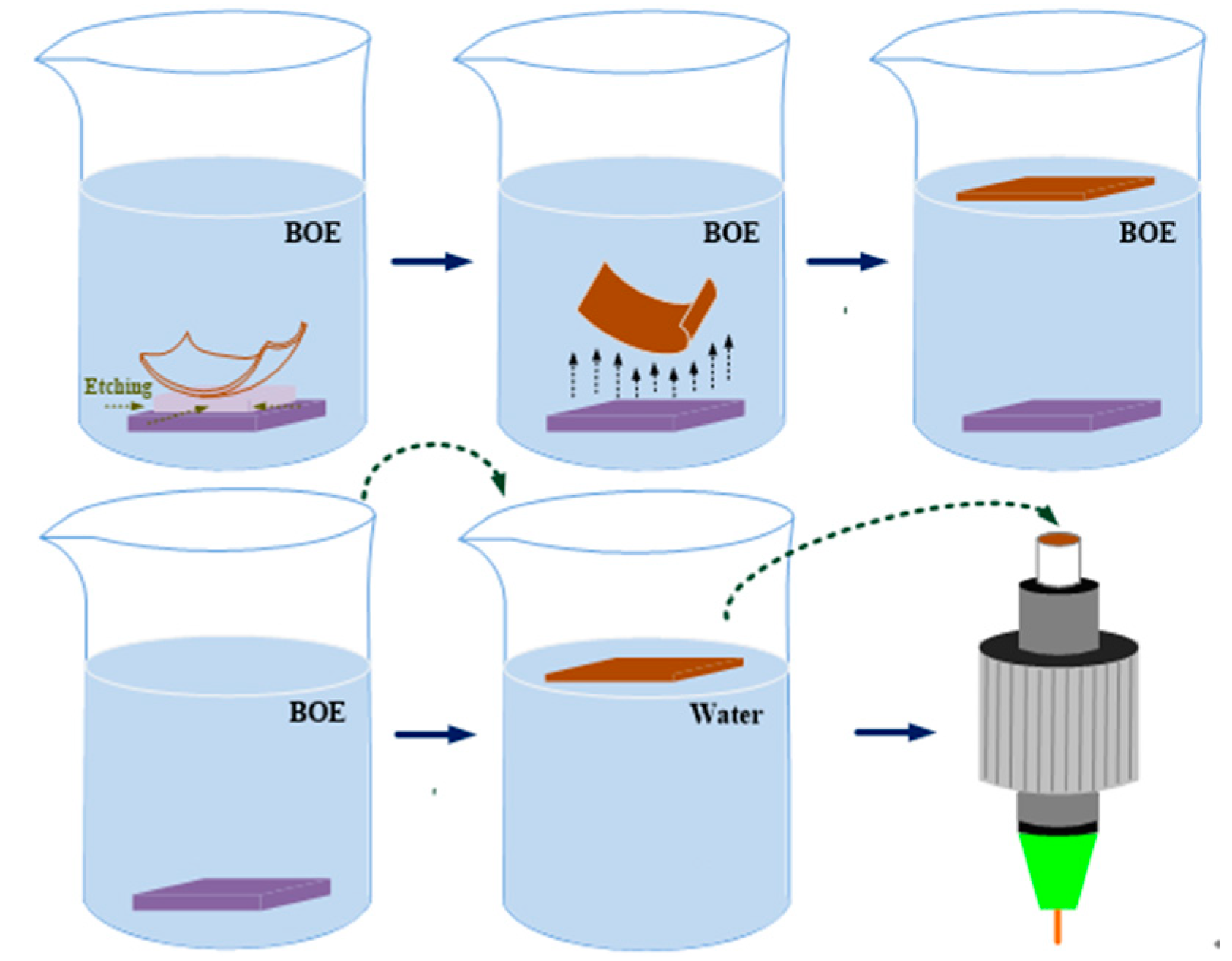
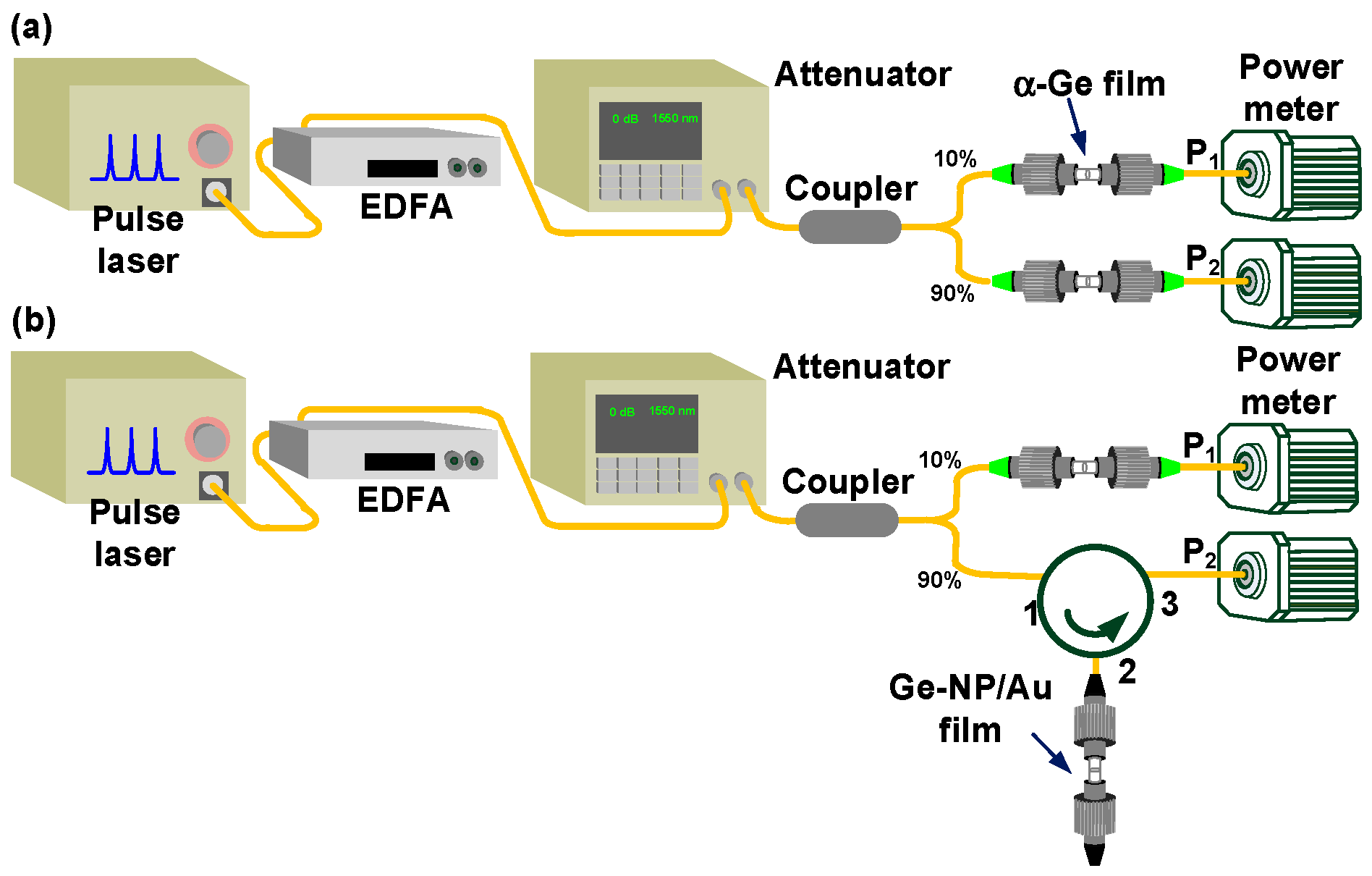
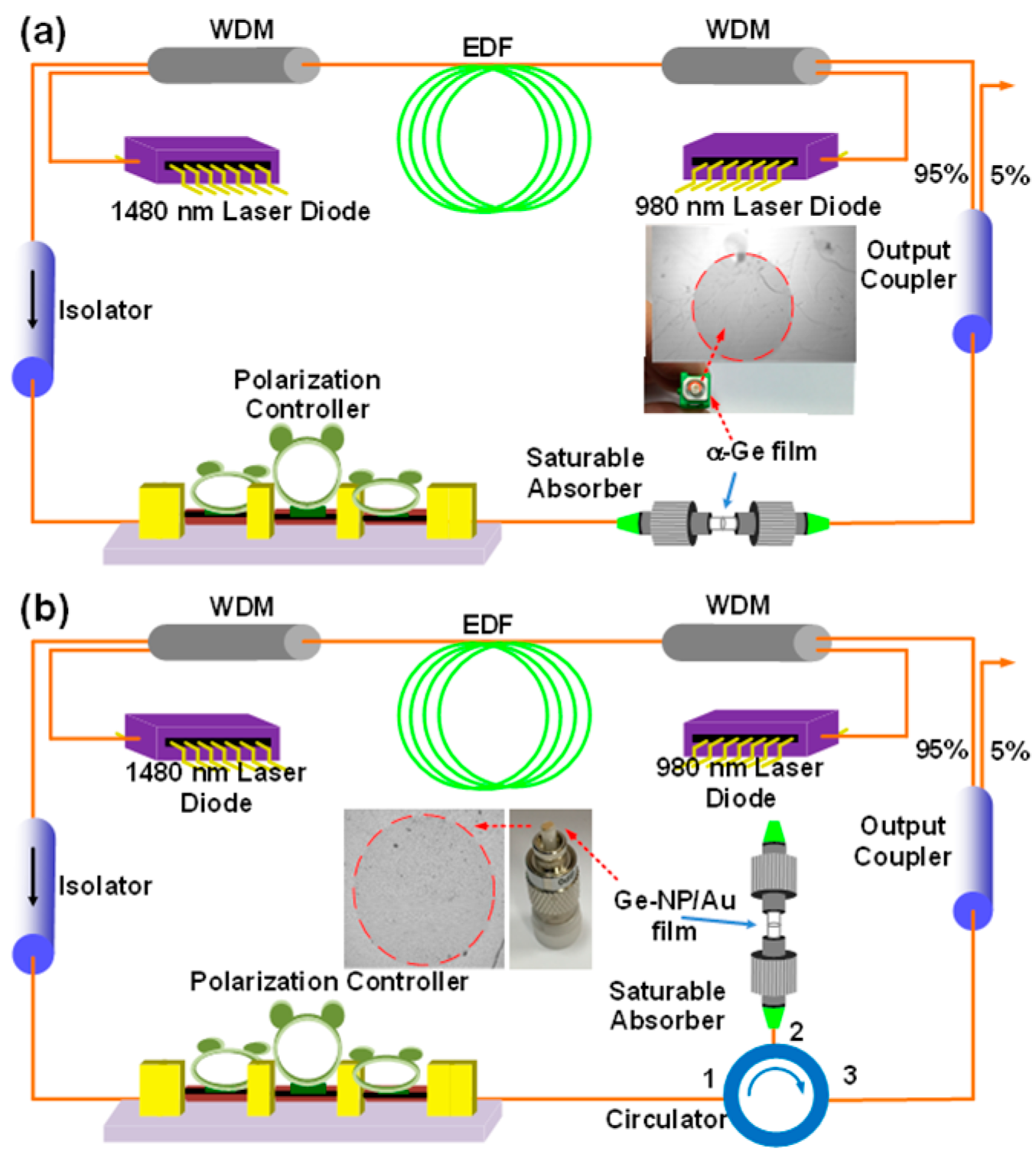


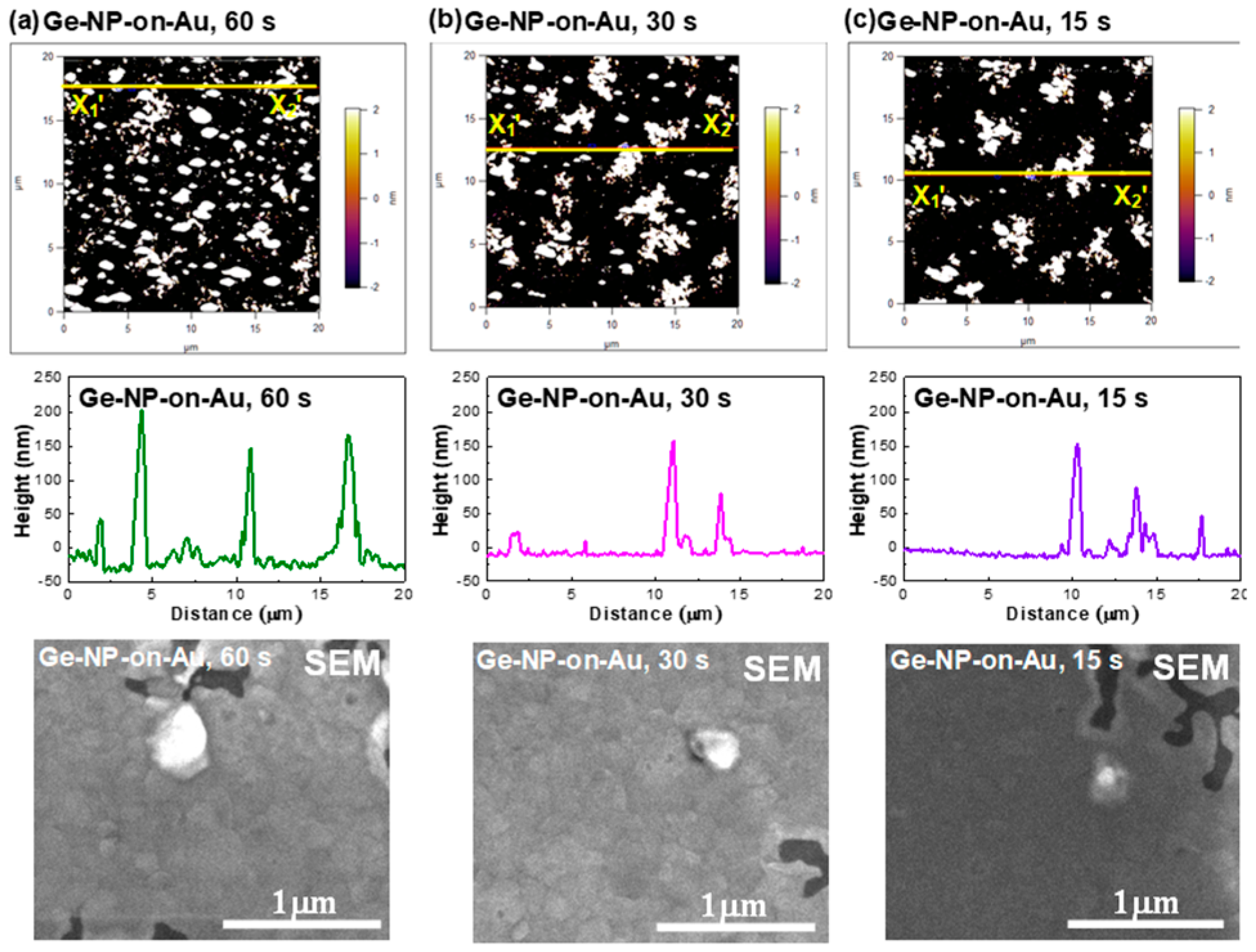

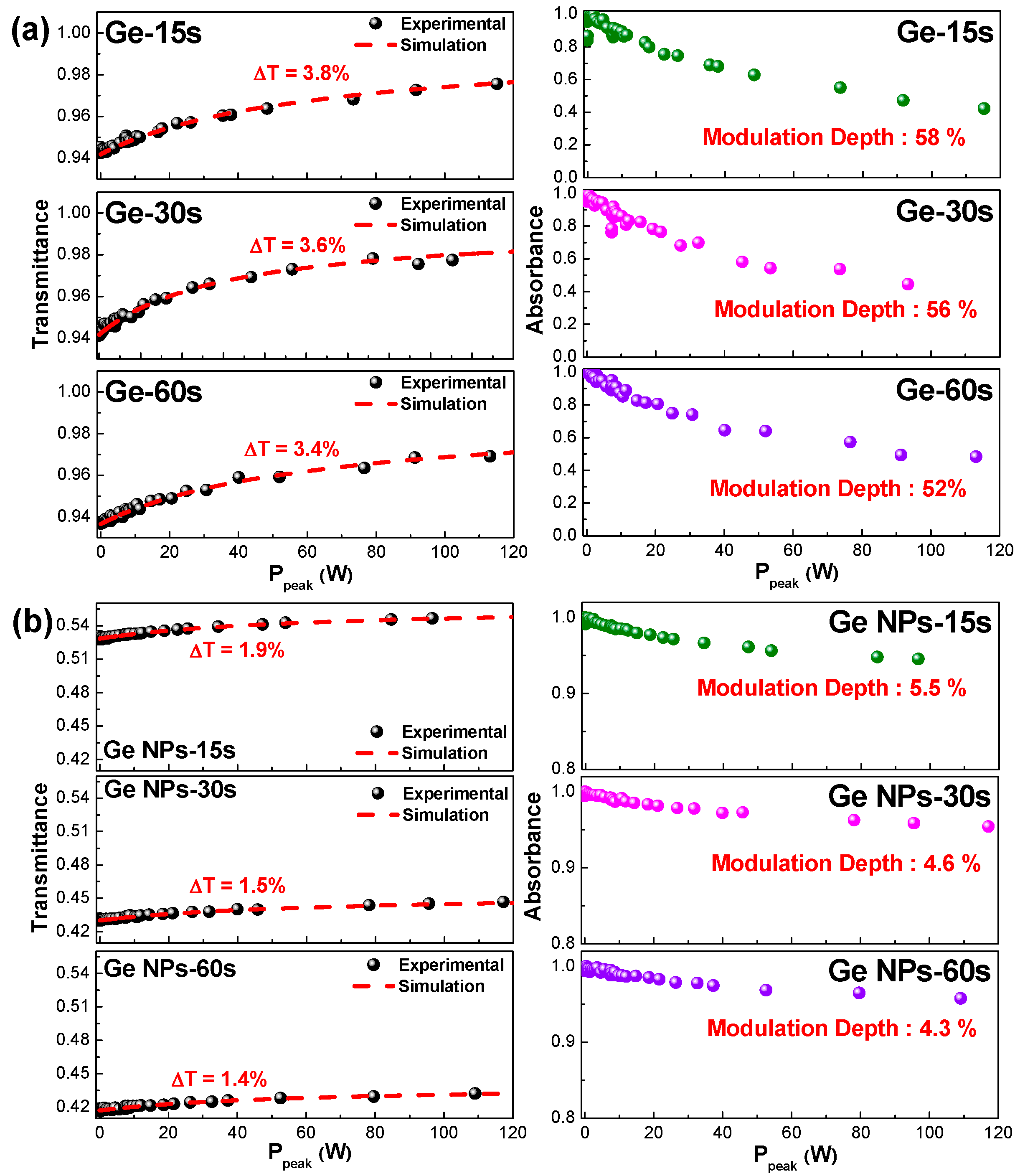

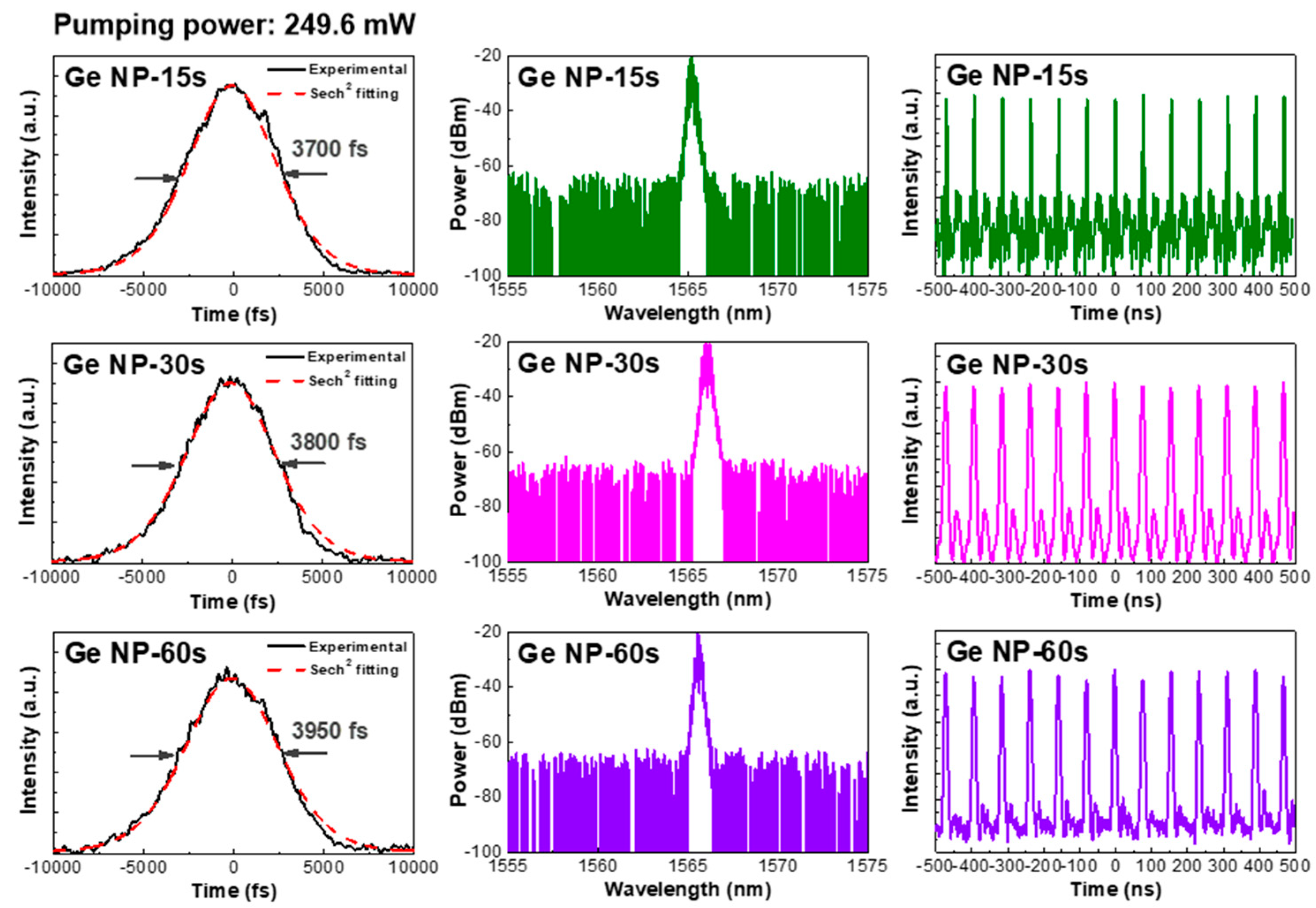
| Deposition Time (s) | 15 | 30 | 60 |
|---|---|---|---|
| [GeH4/Ar] (sccm) | 0.3:2.7 | ||
| Temperature (°C) | 350 | ||
| Power (W) | 50 | ||
| Deposition Time (s) | 15 | 30 | 60 |
|---|---|---|---|
| Linear absorbance qlin | 0.011 | 0.0061 | 0.0056 |
| Nonlinear absorbance qnon | 0.0545 | 0.054 | 0.0543 |
| Saturation power Psat (W) | 61.25 | 60.42 | 60.73 |
| SAM coefficient | 8.90 × 10−4 | 8.93 × 10−4 | 8.94 × 10−4 |
| Modulation depth | 58% | 56% | 52% |
| Deposition Time (s) | 15 | 30 | 60 |
|---|---|---|---|
| Linear absorbance qlin | 0.011 | 0.0061 | 0.0056 |
| Nonlinear absorbance qnon | 0.0545 | 0.054 | 0.0543 |
| Saturation power Psat (W) | 61.25 | 60.42 | 60.73 |
| SAM coefficient | 8.90 × 10−4 | 8.93 × 10−4 | 8.94 × 10−4 |
Disclaimer/Publisher’s Note: The statements, opinions and data contained in all publications are solely those of the individual author(s) and contributor(s) and not of MDPI and/or the editor(s). MDPI and/or the editor(s) disclaim responsibility for any injury to people or property resulting from any ideas, methods, instructions or products referred to in the content. |
© 2023 by the authors. Licensee MDPI, Basel, Switzerland. This article is an open access article distributed under the terms and conditions of the Creative Commons Attribution (CC BY) license (https://creativecommons.org/licenses/by/4.0/).
Share and Cite
Yang, C.-C.; Cheng, C.-H.; Chen, T.-H.; Lin, Y.-H.; He, J.-H.; Tsai, D.-P.; Lin, G.-R. Synthesis of Nano-Structured Ge as Transmissive or Reflective Saturable Absorber for Mode-Locked Fiber Laser. Nanomaterials 2023, 13, 1697. https://doi.org/10.3390/nano13101697
Yang C-C, Cheng C-H, Chen T-H, Lin Y-H, He J-H, Tsai D-P, Lin G-R. Synthesis of Nano-Structured Ge as Transmissive or Reflective Saturable Absorber for Mode-Locked Fiber Laser. Nanomaterials. 2023; 13(10):1697. https://doi.org/10.3390/nano13101697
Chicago/Turabian StyleYang, Chi-Cheng, Chih-Hsien Cheng, Ting-Hui Chen, Yung-Hsiang Lin, Jr-Hau He, Din-Ping Tsai, and Gong-Ru Lin. 2023. "Synthesis of Nano-Structured Ge as Transmissive or Reflective Saturable Absorber for Mode-Locked Fiber Laser" Nanomaterials 13, no. 10: 1697. https://doi.org/10.3390/nano13101697





